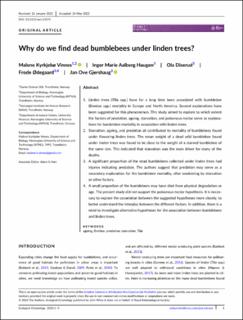| dc.contributor.author | Vinnes, Malene Kyrkjebø | |
| dc.contributor.author | Haugen, Inger Marie Aalberg | |
| dc.contributor.author | Diserud, Ola Håvard | |
| dc.contributor.author | Ødegaard, Frode | |
| dc.contributor.author | Gjershaug, Jan Ove | |
| dc.coverage.spatial | Europe, North America | en_US |
| dc.date.accessioned | 2022-08-09T07:30:03Z | |
| dc.date.available | 2022-08-09T07:30:03Z | |
| dc.date.created | 2022-06-20T13:21:07Z | |
| dc.date.issued | 2022 | |
| dc.identifier.issn | 0307-6946 | |
| dc.identifier.uri | https://hdl.handle.net/11250/3010702 | |
| dc.description.abstract | 1. Linden trees (Tilia spp.) have for a long time been associated with bumblebee (Bombus spp.) mortality in Europe and North America. Several explanations have been suggested for this phenomenon. This study aimed to explore to which extent the factors of predation, ageing, starvation, and poisonous nectar serve as explanations for bumblebee mortality in association with linden trees. 2. Starvation, ageing, and predation all contributed to mortality of bumblebees found under flowering linden trees. The mean weight of a dead wild bumblebee found under linden trees was found to be close to the weight of a starved bumblebee of the same size. This indicated that starvation was the main driver for many of the deaths. 3. A significant proportion of the dead bumblebees collected under linden trees had injuries indicating predation. The authors suggest that predation may serve as a secondary explanation for the bumblebee mortality, after weakening by starvation or other factors. 4. A small proportion of the bumblebees may have died from physical degradation or age. The present study did not support the poisonous nectar hypothesis. It is necessary to explore the covariation between the suggested hypotheses more closely, to better understand the interplay between the different factors. In addition, there is a need to investigate alternative hypotheses for the association between bumblebees and linden trees. ageing, Bombus, predation, starvation, Tilia | en_US |
| dc.language.iso | eng | en_US |
| dc.rights | Attribution-NonCommercial-NoDerivatives 4.0 Internasjonal | * |
| dc.rights.uri | http://creativecommons.org/licenses/by-nc-nd/4.0/deed.no | * |
| dc.subject | ageing | en_US |
| dc.subject | Bombus | en_US |
| dc.subject | predation | en_US |
| dc.subject | starvation | en_US |
| dc.subject | Tilia | en_US |
| dc.title | Why do we find dead bumblebees under linden trees? | en_US |
| dc.title.alternative | Why do we find dead bumblebees under linden trees? | en_US |
| dc.type | Peer reviewed | en_US |
| dc.type | Journal article | en_US |
| dc.description.version | publishedVersion | en_US |
| dc.rights.holder | © 2022 The Authors | en_US |
| dc.subject.nsi | VDP::Zoologiske og botaniske fag: 480 | en_US |
| dc.subject.nsi | VDP::Zoology and botany: 480 | en_US |
| dc.source.journal | Ecological Entomology | en_US |
| dc.identifier.doi | 10.1111/een.13175 | |
| dc.identifier.cristin | 2033455 | |
| dc.relation.project | Egen institusjon: Norwegian institute for nature research (NINA) | en_US |
| dc.relation.project | Andre: Directorate for Nature Management in Norway | en_US |
| cristin.ispublished | true | |
| cristin.fulltext | original | |
| cristin.qualitycode | 1 | |

